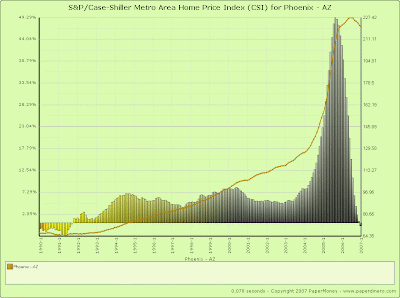
Richard W. Fisher, President of the Federal Reserve Bank of Dallas, yesterday addressed the Austin Mortgage Bankers Association and spoke candidly and quite colorfully about the role of risk in the economy and his outlook on subprime meltdown.
Fisher initially sets up his discussion by recounting some of the truly astounding events that surrounded the Texas real estate collapse of the early 80’s when, prompted by the decline of the Texas oil market, both the residential and commercial real estate markets reverted to the mean.
“Bank and thrift failures reached a frightful magnitude. More than 800 Texas financial institutions went out of business. … The energy bust reverberated throughout the state and it was keenly felt in both commercial and residential and real estate markets.”
“Troubles in the residential sector go so bad, the city of Garland, which is a Dallas suburb, authorized a condo development project that was interrupted by the collapsed market, be set on fire. Burning it to the ground seemed to be the best choice for the 240 unfinished condos that had become eyesores and safety hazards in the twinkle of a financial cycle’s eye.”
“I think I’ve got your attention… this is pretty bracing stuff.”
Fisher then goes on to outline some the recent and largely untested innovations used to mitigate risk in the financial markets.
“It is now possible to mitigate risk through securitization, as you know, and the use of derivative products to a degree that was unimaginable; they just hadn’t been invented, in the 1980’s”
“All these advances has increased liquidity, diversified portfolios, and allocated risk to those more willing to bare it.“
“The fastest growth has been in credit derivatives which, by some measures, increased by 55% last year and by tenfold for the last three years. By any account, the growth in structured credit products has been enormous.”
“Slightly more than 40% of all collateralized debt obligations, or what are know known as CDO’s, last year were set up by first time issuers that have never managed through a downturn in the credit cycle… so the memory cells begin to tingle.”
At this point you get the idea of where Fisher is heading.
The economy (and all of it’s participants), although more educated and in turn sophisticated, by having come through past eras of risk and failure, becomes increasingly more enigmatic, not necessarily more certain or stable, as new innovations are introduced. Not to mention the basic tendency to repeat past mistakes.
Fisher goes on:
“The danger lies in placing too much faith in historical value at risk estimates, especially when they are based on limited experience with new products. Wrong probabilities … can lead very costly mistakes.”
“The real world has a very nasty habit of reminding us every so often, like Texas in the 1980’s or Long Term Capital Management of the 1990’s, and the subprime mortgage market today.”
“It takes extraordinary discipline for financial institutions and investors and agents to exercise sound judgment when the fish are schooling, swimming in pools of mass-liquidity, unencumbered by memory.”
In an effort to outline the issues with some of the new innovations, particularly credit default swaps, Fisher quotes Charles Dickens:
“A person who cannot pay gets another person who cannot pay to say he can pay.”
Fisher continues:
“So, more that 150 years ago, Charles Dickens foreshadowed one of today’s most vexing problems with structured products … knowing just where the risk is and who is ultimately holding it. Who ultimately pays when things go wrong?”
“If your looking for a financial segment where these issues have come home to roost, you need only look no further than the subprime mortgage market.”
“Only recently have we seen widespread use of a number of innovative mortgage products, such as interest only loans and option ARMs. And these innovations are now common even in the subprime sector, which itself has grown tremendously.”
“The most innovative mortgage products have tended to be used more in markets with the greatest appreciation, which suggests that some homebuyers stretched themselves financially to purchase increasingly expensive homes.”
“In many cases homebuyers may have had no other choice if they wished to purchase a home. By easing the qualifying process, these instruments have made home mortgage credit available to broader segments of society.”
“… these innovations have left homebuyers exposed to a decline in the housing market and rising interest rates or both.”
“We must not forget that these new products have yet to be tested in a downturn in the credit cycle.”
Later, in the Q&A portion of the appearance Fisher was asked what the Federal Reserve can do to help clear any significant meltdown in the subprime mortgage market.
Fisher responds:
“My view is, and this is only me speaking personally, I don’t think we should be in the business of focusing on any one asset class. I don’t think we should be in the business of making markets happy.”
The entire speech can be
viewed now at BNN!



























